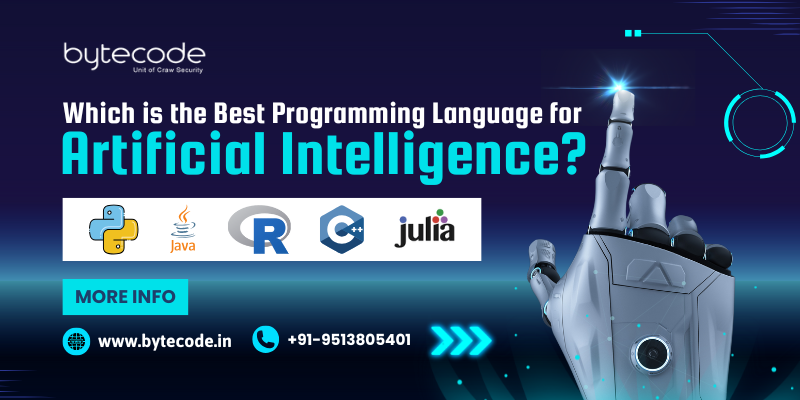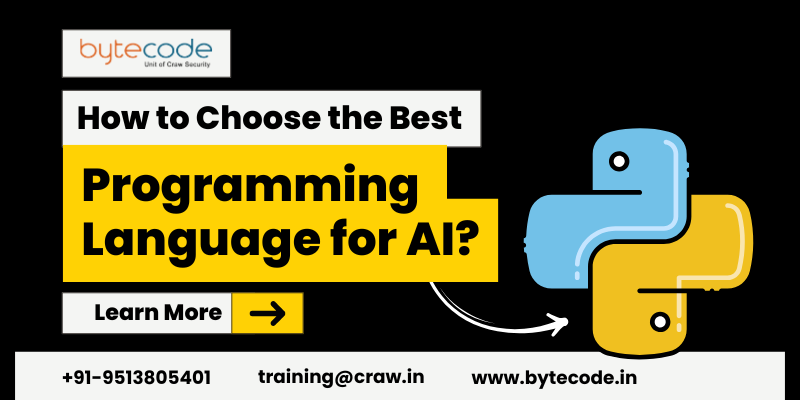Top 10 Programming Language for Artificial Intelligence
Artificial intelligence (AI) is transforming many industries worldwide from healthcare, finance, IT, ecommerce to education. But have you ever wondered what makes AI so powerful? The reason behind that is the use of programming languages.
Choosing the right programming language is crucial for building AI applications, as each language offers unique strengths for different AI tasks. In this article, we will be going to explore some of the top programming language for artificial intelligence, their key features and how you can choose the best programming language for AI.
What Are AI Programming Languages?
In simple terms, AI programming languages are the specialized tools designed for building intelligent systems, machine learning algorithms, and deep learning models. They provide libraries, frameworks, and processing capabilities that streamline the development of AI technologies.
These languages help develop:
- Machine Learning (ML) models
- Natural Language Processing (NLP) applications
- Robotics and Automation
- Neural Networks and Deep Learning
Each AI programming language has unique strengths, making it suitable for different AI applications. Now, let’s dive into the top programming language for artificial intelligence in 2025!
Top Programming Language for Artificial Intelligence
- Abundant Libraries and Frameworks: Tools like TensorFlow, PyTorch, Keras, Scikit-learn, and NumPy simplify the process of developing artificial intelligence.
- User-Friendly: The straightforward syntax of Python enables developers to concentrate on algorithms instead of getting bogged down by complicated code.
- Vibrant Community: A robust and engaged community offers extensive support, tutorials, and access to pre-trained models.
- Compatibility and Scalability: Python works seamlessly with other programming languages and scales effectively for AI-related applications.
- Machine Learning and Deep Learning
- Natural Language Processing (NLP)
- Computer Vision
- Data Science & Analytics
R
- Data Analysis & Visualization: Libraries like ggplot2, dplyr, and caret are super helpful for messing around with data and creating cool visualizations.
- Statistical Computing: R excels in statistical modeling, which is crucial for AI research.
- Machine Learning Support: Packages like randomForest, e1071, and xgboost support machine learning tasks.
- Statistical Analysis
- Predictive Modeling
- AI Research
- Bioinformatics
Java
- Portability: Java apps can run on different platforms without any hassle.
- Scalability: It’s a great fit for big AI projects.
- AI & ML Libraries: Tools like Deeplearning4j, Weka, and MOA make it easier to dive into AI development.
- Enterprise-Level Use: A lot of big companies choose Java for AI because it’s reliable and secure.
- AI-powered Web Applications
- Enterprise-Level AI Systems
- Robotics and Automation
C++
- Boosted Performance: Speeding up how AI algorithms and models run.
- Better Resource Management: Gives you a clearer view of system resources.
- Used in AI Frameworks: C++ versions are available in libraries like TensorFlow and OpenCV.
- Computer Vision
- Game Development AI
- Real-Time AI Systems
Julia
- Speed and Efficiency: Executes faster than Python and R.
- Parallel Computing: Perfect for managing large datasets.
- Expanding AI Libraries: Flux.jl and MLJ.jl are well-known AI libraries built on Julia.
- High-Performance Machine Learning
- Scientific Computing
- AI in Finance and Healthcare
JavaScript
JavaScript is a powerful language for web applications that utilize AI, enabling interactive and responsive AI features directly in the browser.
Why Choose JavaScript for AI?
- Web AI Integration: Works with front-end and back-end frameworks.
- Supports TensorFlow.js: Enables machine learning in the browser.
- Large Developer Community: Continuous updates and support.
Best Use Cases
- AI-Powered Chatbots
- Recommendation Systems
- Browser-Based Machine Learning
Lisp
Lisp is one of the oldest programming languages for artificial intelligence, recognized for its flexibility and strong symbolic computation abilities.
Why Choose Lisp for AI?
- Great for AI Research: Supports logic-based AI development.
Dynamic and Flexible: Ideal for rapid prototyping.
Used in Early AI Systems: Played a key role in early AI advancements.
Best Use Cases
- Natural Language Processing (NLP)
- Expert Systems
- Symbolic Reasoning
Haskell
Haskell is a functional programming language known for its reliability and precision, making it an top programming language for artificial intelligence that require mathematical accuracy.
Why Choose Haskell for AI?
- Strong Type System: Prevents errors in AI models.
- Great for Theoretical AI: Used in research-heavy AI projects.
- Efficient and Scalable: Ideal for complex algorithms.
Best Use Cases
- AI-Based Theorem Proving
- Mathematical Modeling
- Predictive Analytics
Prolog
Prolog is a logic-based programming language used in AI applications that require rule-based reasoning and decision-making.
Why Choose Prolog for AI?
- Best for Knowledge-Based AI: Supports logical inference and rule-based systems.
- Great for Problem-Solving AI: Used in expert and decision-making systems.
- Ideal for NLP Applications: Well-suited for AI-driven language understanding.
Best Use Cases
- AI-Powered Medical Diagnosis
- Natural Language Processing (NLP)
- Rule-Based Decision Systems
Scala
Scala is a modern, high-performance programming language that integrates smoothly with AI frameworks, making it best programming language for ai, ideal for applications that require extensive data processing.
Why Choose Scala for AI?
- Great for Big Data AI Applications: Works well with Apache Spark.
- Runs on JVM: Easily integrates with Java-based AI systems.
- Highly Scalable: Suitable for enterprise AI solutions.
Best Use Cases
- Big Data AI Processing
- Large-Scale Machine Learning Models
- AI-Powered Financial Analytics
How to choose the best programming language for AI?
- Libraries and Frameworks – Artificial intelligence and machine learning libraries make life easier for developers by offering ready-to-use functions and models. This significantly cuts down the time needed for development.
- Performance –AI algorithms need to work swiftly and efficiently to analyze data and make decisions in real time.
- Scalability – AI applications need to scale effectively to handle large datasets and complex calculations. They should also support distributed computing and parallel processing to boost overall performance.
- Community Support – A vibrant developer community fosters a dynamic environment by providing ongoing improvements and resources. This support helps members tackle challenges effectively and stay informed about the latest trends.
- Ease of Learning – The design of a programming language greatly affects how quickly developers can learn AI. Beginners typically prefer languages with simple syntax and thorough documentation.


